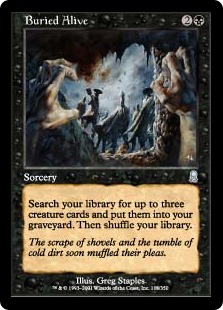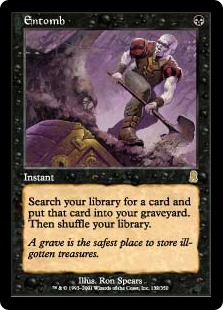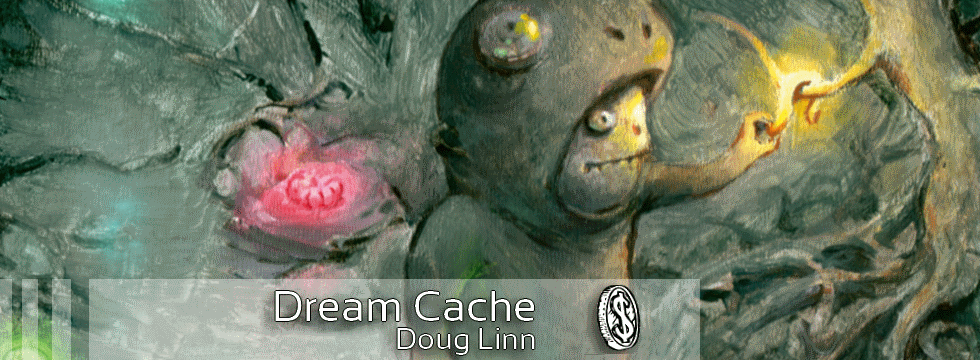Are you a Quiet Speculation member?
If not, now is a perfect time to join up! Our powerful tools, breaking-news analysis, and exclusive Discord channel will make sure you stay up to date and ahead of the curve.
Odyssey came off the heels of the fan-favorite Invasion Block. While Invasion's theme was gold cards, Odyssey's theme regarded the graveyard as a resource. Wizards R&D designed cards to exploit two previously-neglected ideas – benefits when one discards a card (the Madness mechanic) and the number of cards in the graveyard (Threshold). Although both mechanics were dynamite tournament successes (along with Aether Flashback), I don't think players understood them well. If you saw Wild Mongrel without support cards like Roar of the Wurm, you might wonder when you would ever sacrifice a valuable card in hand for a +1/+1 bump. Similarly, if you saw Threshold cards without attendants like Mental Note, it may seem like you'd never get that magical seven cards until too late. It's a cerebral set, since so many of the cards interlace. You can use a Psychatog to discard a Deep Analysis and then flash it back on the cheap. That's a subtle interaction that rewards veteran players, but breezes past newer players. Thus, to many, Odyssey seemed underpowered unless they understood these interactions.
On the upside, Odyssey has a great selection of casual and Legacy favorites. It's shot-through with dollar cards and fun foils that command a good price on the secondary market. Let's look at them!
The Aegis is a perfect foil to those annoying burn players you run into. It's even better in multiplayer because it doesn't just shut down burn against you, it points that heat at someone else. In some ways, it acts like a punishing Circle of Protection. They're moderately in-demand by people who are probably looking for the best way to shut down burn players in their circle.
$1.25
Braids has the notoriety of being one of two creatures banned as an EDH general. On the first or second turn, a Braids can blow away an opponent's development. She's in Dark Ritual colors, too. Braids is somewhat-common as a casual card, but since it's so old, many players are simply unaware that it exists.
$1.25

Buried Alive first showed up in Weatherlight, where it formed the engine of a particular deck. It was a Black Weenie deck oriented around Ashen Ghoul and Nether Shadow and pumped up by Bad Moon. Buried Alive would bin three Ghouls or Nether Shadows. They would start coming out and never stop. Two Buried Alives would put an opponent under a wall of monsters that would basically never die.
Buried Alive has shifted to be a Reanimator card, instead. It can set up a lethal array of monsters that come out with Reya Dawnbringer. It grabs three Squee, Goblin Nabobs so a player can make the most of their Bazaar of Baghdad. It's impressive that a seemingly worthless card gets so much casual play. It's a great card to pluck from uncommons boxes when you can find them.
$2.25
I remember Call coming out and people positively flipping out over the card. It's a solid tournament card, but it's dreadfully boring. All you get is two dumb Elephants for a pretty good price. It sat a the core of Tomi Walamies' “Dumbo Drop” control deck in old Extended. It used Artificer's Intuition and Archangel of Tithes to thin down the deck, then recycle the good cards with Gaea's Blessing. Walamies could put an immediate clock out by tossing Artificer's Intuition into three Calls. Call also saw a lot of play in Standard in a Red/Green aggro deck, which would utilize it with cards like Elephant Guide and Grim Lavamancer.
Call was reprinted in Time Spiral, but it largely failed to make an impact on Standard. My guess is that the cards and spells in the environment were just too punishing for slow 3/3s. You'd have to fight Tendrils of Corruption, Mystical Teachings, Choice of Damnations and more. Though Call went for $18 or more when it was originally in Standard, the reprinting and lack of tournament play have driven the value of Call into the ground.
$1.50
Careful Study fuels Dredge and nostalgic Madness decks. On its own, it's worth about a quarter; as a foil, substantially more.
$6.00 in foil
This is another must-grab if you find it in uncommons boxes! The Coliseum saw a lot of play in Standard because it was great for pumping up Psychatog. You could use it to filter through excess lands or useless spells. Its big role these days is satisfying three more Canal Dredger activations in Legacy. Lots of people like to play Canal Dredger and Coliseum is a solid trade card. Get them when you can and poke through your collection for spares!
$3.00 ($11.00 in foil)
There are some people who really dig flipping coins. Krark's Thumb makes it a little easier. At one point, Frenetic Efreet received power-level errata because you could put its ability on the stack a billion times and win the game with Chance Encounter out. The errata is gone now, but Chance Encounter is still sought-after. People must love the idea of living the dream with Mana Clash...
$1.50

Here's an interesting one. Crystal Quarry is simply a mana filter. It turns your mana into a spectrum of the rainbow. With no mana burn anymore, the Quarry can more effectively generate the right mana that you need. I've never seen someone play one of these, but people must use them, because they are surprisingly valuable.
$3.50
Darkwater Catacombs and the other filters
The filter-lands from Odyssey were pretty good for their time and showed up in a lot of high-caliber decks. However, they are terrible from a modern deckbuilding standpoint. Compare the new filter lands like Graven Cairns and you'll quickly see why – the Odyssey lands couldn't tap for mana on their own! You would sometimes open this killer hand and see that your only two lands were filters and needed support. How frustrating. The lands are still a little bit desirable, since they can make up a critical mass of dual-color lands in an EDH deck. On their own, they will never be played if one has access to the real filter lands of Eventide.
$1.25-$1.50
The main flaw of Decimate in constructed play was that it required there to be all those targets on the battlefield when you announced the spell. In multiplayer EDH and the like, you're bound to be able to target everything; you can blow up a Maze of Ith, Coalition Relic, Lotus Cobra and Sylvan Library with it, for example. That's an incredible advantage for those two colors. You can even ruin someone's day by giving them a 4-for-1 instead of spreading out the aggression. I'm surprised that Decimate is worth more than bulk; it's a sign that a lot of players are grabbing this for multiplayer.
$2.75
Know that there are really no fair things that the Temple is good for. In my 5-Color Academy deck from ages ago (the 5-color format has a 250 card minimum deck size), I ran a Temple because I would eventually be able to Crop Rotation or Reap and Sow for it to make more mana with Academy. They can be used to untap Maze of Ith, a Cloudpost, part of the Urzatron or more. People use them to get an extra punch out of already-powerful lands. They're nice to have in your trade binder because someone will always want them for their EDH deck.
$1.75
The Caretaker is kind of a Mother of Runes that protects your guy from removal of most kinds. I think Mother of Runes is a bit better, but sometimes you want to double-up on protections. Casual players love the idea of protecting their guys (look at how popular Diplomatic Immunity is...) and this does a good, and affordable, job of it.
$1.75
I feel like Divert has been outclassed by Spell Pierce, but for awhile, it was a critical blowout. Hymn to Tourach coming at you on the first turn? Send it back! Take that Ancestral Recall when you can, too. Though it's terrible later in the game, Divert could protect you from tap-out all-stars like Haunting Echoes and the like. It's still popular enough among players and devious sideboarders to command a premium.
$1.50

Disentomb is back in Legacy and is obviously a Reanimator card. It's never been cheaper to bin a creature to bring back. While on the subject, Disentomb was briefly in Extended along with Worldgorger Dragon and Animate Dead. Oh, Dark Ritual was there, too. If you are unfamiliar with the Dragon combo, the basics are this: you Animate the Dragon. It removes all your permanents, including the Animate. Dragon dies, everything comes back untapped (including lands). Animate looks for a target and then gets Worldgorger back. This happens forever unless you can find another target for the Animate.
This loop would generate infinite mana, and it would often draw games. Dragon was a favorite deck of mine in Vintage, where you could sometimes draw the game and go into the shadow world of Game Four. That's not the worst, though. In Extended, you could Dark Ritual, Disentomb, bin Dragon, then cast Dance of the Dead on it and draw the game if you didn't have a way to kill. This led to some games with hilarious numbers of draws. The best I saw was a matchslip with the record of 2-0-27 on it.
Disentomb went from being $4 to $30 on its unbanning in Legacy, and though it's dropped a little, it's still very pricey. The deck is good and Disentomb is a central part of it.
$24.50
Aura Extraction is like the Great Big Hope. You want to play it on the first turn and grab that one combo kill piece the opponent packs and make them scoop up the game. Problem is, it never turns out that way. I can think of few Vintage combo decks in my day that didn't have alternate win conditions. Best one? Grim Long, which used Grim Tutors to find Yawgmoth's Will for a Tendrils of Agony kill, also ran Elvish Spirit Guides for mana. I have actually seen tournament games where a player loses their Tendrils to Jester's Cap or Aura Extraction and then casts ESG. They then cast Time Walk, then Regrowth the Time Walk to take another turn. After that, one Timetwisters to shuffle them back in and hopefully, can find that Time Walk again. Regrowth gets back the Timetwister and the loop starts all over again. This is greatly aided by a giant Mind's Desire that exiles most of a player's library.
Aura Extraction keeps people hoping, apparently enough to drive up its price.
$1.50
iBlood has been a player classic because it's great for untargeted removal. Again, worth little regularly, but valuable as a foil.
$8.00 in foil
This Angel is expensive to cast, for sure. It reminded a lot of people of Morphling, since she was nearly unkillable with most of the usual ways. It is important mainly for Angel collectors, and fetches a substantial sum in foil.
$13.00 in foil

Karmic Justice sees most of its play in Enchantress decks in Legacy. Two Agrus Kos, Spirit of Justices on the board will make an opponent hesitant to use any of their spot removal. It's also pretty sharp for shutting down Wasteland recursion with Crucible of Worlds. Karmic Justice is superb in multiplayer because it makes all those frustrating spells go elsewhere; it never will destroy a permanent, but it will protect everything else you have.
$2.50
This card is really only valuable because of its creature type – Squirrel. It's not great with token generation but hey, it Might of Oaks itself. Kind of silly, really.
$1.75
Join me again next week as we take a look at the second half of Odyssey. We didn't even get to Jon Finkel, Dr. Teeth or the new Ancestral Recall! You'll have to come back next week for those!
Until then,
Doug Linn
twitter.com/legacysallure




